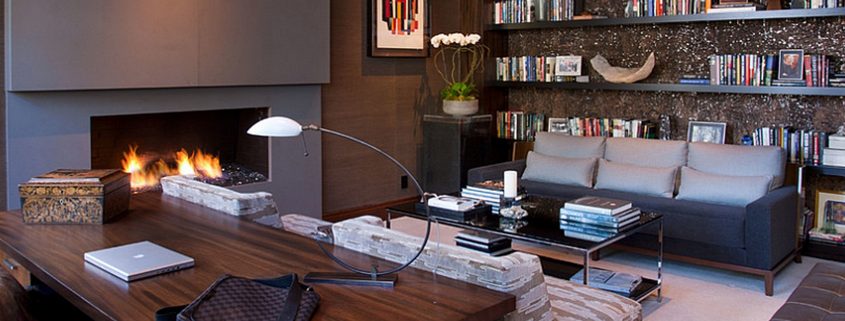Bringing Your Office Into Balance with Feng Shui
Feng Shui is the art of placement. It is an ancient Chinese design discipline that focuses on balancing the elements of a space to create a harmonious environment where energy, or “chi”, flows unencumbered throughout the space. The goal of Feng Shui is to bring a sense of balance, calm and harmony into the room by placing furniture in a manner that will not impede movement. Businesses looking to switch things up in their offices should consider implementing the elements of Feng Shui to improve the overall layout and resulting energy of their workplace. It can bring subtle beneficial change to productivity and workflow.
Begin by considering how you can introduce the five elements of Feng Shui—wood, fire, earth, metal and water—into your space. Here are some things to consider when you want to create better alignment in your office environment:
Water Elements
Incorporating moving water into the entry of a workplace helps add the natural component of motion and is said to pool the positive energy that ultimately brings success. Incorporating a small fountain or water feature can improve wellness and promote biophilic design. Small circulating fountains that are placed in northern facing portions of the room are said to improve prosperity—entrances and exits are the most important areas to consider when positioning these elements. The water must be clean and refreshed daily to exemplify fresh energy. Aquariums that incorporate natural stone and live plants are also a great way to bring this element into an office space. They create a strong sense of tranquility in any environment. But they must be kept well maintained and clean to provide the best Feng Shui energy.
Strong Entrance
Entrances are considered important in Feng Shui since the energy of a room is immediately affected when someone enters the space. Use entrances to make strong first impressions that set the color, tone, and vibe for your office culture. Keep the entrance area clean and vibrant. Avoid sharp, square edges by providing a curved reception desk area, which will keep the flow of energy moving around the space. Greenery is also essential for managing the electromagnetic noise and negative energy found amidst all the technology of modern offices. Entries are an excellent opportunity to introduce the subtle patterns and colors that corroborate your brand story.
Remove Clutter
De-cluttering is not directly included in the ancient principles of Feng Shui, but it is often mentioned due to its effect on energy within a space. Clutter in the office and on your desk can negatively impact your energy and workflow and impede performance. Having a clean, clear desk can help employees stay focused on the tasks at hand. Work generates a lot of paraphernalia: papers, files, books, etc. Provide plenty of stylish storage solutions around your office to keep paper files neat and organized and avoid the stagnating energy associated with clutter. Keeping the office clutter-free promotes productivity, ensures that the area will always be presentable to clients and comes with the added benefit of freeing up more usable space in the office.
Optimize Your Break Room
Kitchen areas hold special importance in the practice of Feng Shui. Traditionally, they represent a place of nourishment and family. In an office setting, they are important because they offer employees a place to relax, regenerate, connect and feed their mind. In Feng Shui, kitchens are ideally placed away from main entrances and bathrooms to promote good “chi”. Changing the positioning of the kitchen in your office space may not be possible, but managers can use strategically placed furniture, greenery or art to liven up breakrooms and balance the fire [cooking] and water [sink] elements found in a kitchen setting. Round tables allow the energy to move around the room and promote communal conversation. Wood or cork flooring are the best choices for surfaces.
Optimally Position Your Desk
The correct placement of the desk in a room can have a large effect on productivity. The arrangement can affect everything from exposure to natural light to the sense of wellbeing in the entire office. Facing the entry point is considered the “command position” that allows a person to feel a sense of control over their own environment. Feng Shui practices recommend placing desks in positions that face the entry point of the room, just slightly off the door, never facing the door directly. L-shaped desks should float in the space so they allow the occupant to face the enrty and have solid fronts that allow for cords to be concealed from visitors. Cubicles are a bit tricky, do the best you can to get yourself situated in a command position. If this is not possible, utilize a desk mirror near your monitor so you can see anyone coming up behind you. Task lighting and plants can also help your cubicle area seem less closed in. Sitting in front of walls or dividers can hinder creativity and block inspiration. Placing desks so team members have a wide view of the room with their backs facing a wall can improve a sense of trust. Low divider benching solutions that allow a clear view over the span of the office can accomplish this very well. Make sure the view is orientated toward something beautiful, perhaps a window or a painting…not disruptive hallways, other rooms, bathrooms or clutter.
Utilize Color
Feng Shiu practices utilize colors that correspond to the five elements of Wood, Fire, Earth, Metal, and Water with varying effects on your work life. Aim for a balanced and serene ambiance that blends the light and dark colors with ease. Do not just use all neutrals or plain white, as it can lead to a boring space with flat energy. Add bright pops of your branding colors, red, green or yellow to create some vibrant energy, with a combination of different textures such as metal, glass, wood, and stone to create a balance of elements within the space:
- Wood, the element of new beginnings, growth, and teamwork, is represented by medium or light blues and greens. Wood colors are most useful when you are working on new projects, trying to create a sense of teamwork and growth, when your business is connected with investment growth, or when you are concerned about the general health of your career.
- Fire is the “showiest” element, indicating the high energy and visibility associated with fame and reputation. Reds and dark pinks represent Fire in your environment. Fire colors add a spark of vitality and passion to your business. These colors are most typically used in marketing to increase your company’s visibility. You can use Fire colors as accents in more imaginative ways like red file folders, red chairs, or red artwork.
- Earth colors are associated with yellow, gold and tan and represent stability and nourishment. Earth colors are considered the colors of centralized authority, power, and control. Use these colors when stability is a fundamental business value. Businesses that benefit from Earth colors include accounting and law firms, where a steady, authoritative approach is the key to success. Earth is also appropriate when the going gets rough and you need to steady your business nerves!
- Metal represents calmness, creativity, organization and good planning. Its color is white. You’ve probably noticed how common white is in business décor; this is because every business benefits from good preparation and execution! If you find yourself in an environment that’s overly Metal/white, use the other elements to bring it into balance. The coolness of Metal is controlled by the warmth of Fire, so bring some red accents into your office to add passion and enthusiasm to your workday.
- Water represents insight, creative perception, and mystery. Its color is black and very dark shades of blue. Water hues are wonderful if you’re in a creative field where ideas need to flow freely. So it’s a great element to utilize when you need to think “out of the box” and get your creative juices flowing about your business.
As with any office, good space planning is the foundation of a successful design. Productivity, color and the balance of elements seem so effortless in the design process, but there is always a great deal of planning and forethought that go into creating the most productive office design for your team. By applying the principles of Feng Shui to your office design, a boring and disorganized space can easily transform into a functional work area with productive intention.
 MEET CHELLY BELL: Chelly provides a well-rounded approach to your office furniture selection. Her visionary skills will help you find the best furniture solutions for your office design. Connect with her via email chelly@officefurniturenow.com or by calling 888-910-3769 x137.
MEET CHELLY BELL: Chelly provides a well-rounded approach to your office furniture selection. Her visionary skills will help you find the best furniture solutions for your office design. Connect with her via email chelly@officefurniturenow.com or by calling 888-910-3769 x137.



